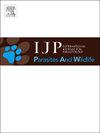Host-related genetic differentiation of a polyxenic avian ectoparasite, Ornithomya avicularia (Hippoboscidae)
IF 2.2
3区 医学
Q3 ECOLOGY
International Journal for Parasitology-Parasites and Wildlife
Pub Date : 2025-05-12
DOI:10.1016/j.ijppaw.2025.101081
引用次数: 0
Abstract
Ectoparasites play a key role in ecosystems, affecting the health, behaviour, and reproductive success of their hosts. The parasite-host relationships are complex and dynamic, and selective pressures exerted by the hosts can lead to local adaptations and changes in the genetic structure of the parasite population. Our aim was to investigate how parasitism on a diverse range of avian hosts with varying ecology and habitat preferences shapes the genetic variation of the parasite. For this purpose, we quantified the genetic structure and differentiation of host-related populations of a common polyxenic avian ectoparasite Ornithomya avicularia (Hippoboscidae, Ornithomyinae), a louse fly species parasitizing various bird species occupying diverse ecological niches. Using 20 polymorphic microsatellite markers, we genotyped louse flies collected from four phylogenetically (passerine and non-passerine) and ecologically (wetland vs. forest) divergent avian hosts caught during autumn migration. Despite the ecological and phylogenetic differences among hosts, the genetic differentiation among louse fly populations was modest, indicating ongoing gene flow. Bayesian clustering and discriminant analysis identified two genetic clusters with relatively weak barriers to gene flow, but this clustering reflected neither phylogenetic nor ecological differences between hosts. We suggest that the high dispersal abilities and the specific reproductive strategy of O. avicularia likely contribute to the genetic homogeneity of its populations across ecologically and phylogenetically distant hosts. This study provides novel insights into the population genetics of an understudied ectoparasite, with implications for understanding host-parasite interactions and disease transmission in avian systems.

一种多种鸟类外寄生虫——鸟腹虫(Ornithomya avicularia)的宿主遗传分化
体外寄生虫在生态系统中发挥关键作用,影响宿主的健康、行为和繁殖成功。寄主与寄主的关系是复杂而动态的,寄主施加的选择压力可能导致寄主种群的局部适应和遗传结构的变化。我们的目的是研究寄生在不同生态和栖息地偏好的多种鸟类宿主上如何影响寄生虫的遗传变异。为此,我们对一种常见的多种鸟类外寄生虫鸟腹虫(Ornithomya avicularia,鸟腹虫科,鸟腹虫科)的遗传结构和宿主相关种群的分化进行了量化。利用20个多态微卫星标记,对秋季迁徙中捕获的4种不同系统(雀形目和非雀形目)和生态(湿地与森林)不同鸟类宿主的家蝇进行了基因分型。尽管宿主之间存在生态和系统发育上的差异,但蝇类种群间的遗传分化并不明显,表明存在持续的基因流动。贝叶斯聚类和判别分析发现了两个基因流动障碍相对较弱的遗传聚类,但这种聚类既不能反映宿主之间的系统发育差异,也不能反映宿主之间的生态差异。我们认为,高传播能力和特定的繁殖策略可能有助于其种群在生态和系统发育上遥远宿主的遗传同质性。这项研究为一种未被充分研究的外寄生虫的种群遗传学提供了新的见解,对理解宿主-寄生虫相互作用和鸟类系统中的疾病传播具有重要意义。
本文章由计算机程序翻译,如有差异,请以英文原文为准。
求助全文
约1分钟内获得全文
求助全文
来源期刊

International Journal for Parasitology-Parasites and Wildlife
Medicine-Infectious Diseases
CiteScore
3.80
自引率
5.60%
发文量
113
审稿时长
45 days
期刊介绍:
The International Journal for Parasitology: Parasites and Wildlife (IJP-PAW) publishes the results of original research on parasites of all wildlife, invertebrate and vertebrate. This includes free-ranging, wild populations, as well as captive wildlife, semi-domesticated species (e.g. reindeer) and farmed populations of recently domesticated or wild-captured species (e.g. cultured fishes). Articles on all aspects of wildlife parasitology are welcomed including taxonomy, biodiversity and distribution, ecology and epidemiology, population biology and host-parasite relationships. The impact of parasites on the health and conservation of wildlife is seen as an important area covered by the journal especially the potential role of environmental factors, for example climate. Also important to the journal is ''one health'' and the nature of interactions between wildlife, people and domestic animals, including disease emergence and zoonoses.
 求助内容:
求助内容: 应助结果提醒方式:
应助结果提醒方式:


